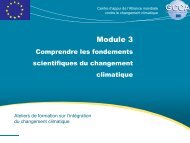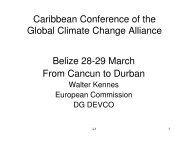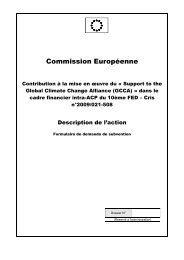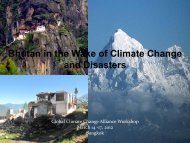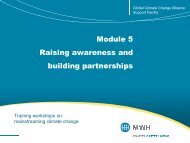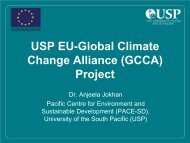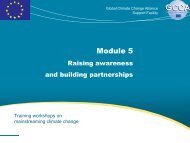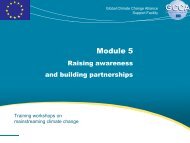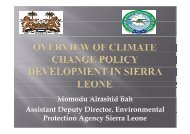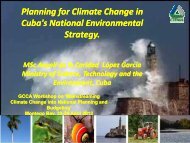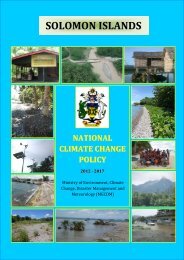Rwanda Green Growth Strategy 18nov11 - Global Climate Change ...
Rwanda Green Growth Strategy 18nov11 - Global Climate Change ...
Rwanda Green Growth Strategy 18nov11 - Global Climate Change ...
Create successful ePaper yourself
Turn your PDF publications into a flip-book with our unique Google optimized e-Paper software.
Chapter 2A <strong>Climate</strong> Resilient and Low Carbon Development Path<strong>Rwanda</strong> has chosen to embark on a low carbon development pathway. To do this, it needs toreduce its dependence on oil, which has the benefits of supporting energy security, reducing vulnerability tooil price spikes, channeling finances into the local economy, creating jobs and promoting economicdevelopment and reducing GHG emissions.<strong>Rwanda</strong> is in the fortunate position of having a renewable low carbon energy resource mix which isthe foundation for a low carbon economy. Although diesel is currently used for 39% of electricityproduction, this can be phased out and replaced with geothermal, hydro and solar which are all cleanenergy sources. Lake Kivu, shared by the DRC and <strong>Rwanda</strong>, hosts methane gas (mixed with CO2) whichleft unexploited poses a safety risk and if released into the atmosphere, is a potent greenhouse gas.Although using the methane to generate electricity will result in carbon emissions, the benefits of domesticenergy security, safety and a possible smaller global warming potential, make this an attractive energysource. <strong>Rwanda</strong> also hosts vast black peat deposits which are largely unexploited and could contribute todomestic energy security in the short term but with high carbon emissions are not a good long term option.This domestic energy mix will enable all consumers of energy – industry, services and the public – to lowertheir GHG emissions. More importantly, it will enable <strong>Rwanda</strong> to provide enough electricity for its growingeconomy. In addition, <strong>Rwanda</strong> has access to the East Africa Power Pool, which in the future may provideregional energy security for ten African countries.Chapter 2: <strong>Rwanda</strong>’s Development PathwayThe biggest challenge for low carbon development is transport – petroleum products will still have tobe imported to supply the needs of the transport sector. Although some work is being done on growingjatropha for biofuels near Akagera National Park in eastern <strong>Rwanda</strong>, the limited land, growing populationand high water requirements for biofuels makes growing biofuels crops a poor option for <strong>Rwanda</strong>. Moreinnovative and cost-effective solutions could include producing ethanol from municipal solid waste and frommethane in Lake Kivu. Oil exploration in Lake Kivu may solve domestic energy security, but will not reducecarbon emissions, and has added complications of the multiple shared energy sources that the lakeprovides. Until a cleaner, cheaper alternative is available, the focus for transport and energy must be onefficiency and demand reduction. This is a win-win option for domestic and industrial consumers oftransport and energy who save on costs while freeing up capacity to extend electricity access across thecountry and reducing GHG emissions.Forests, parks and agroforestry can play a role in low carbon development by acting as carbon sinks.By preserving current forests and parks, agroforestry and urban tree planting, <strong>Rwanda</strong>’s growing emissionscan be reduced. Forests provide ecosystem services, vital for socio-economic development, and supportecotourism which will continue to contribute to economic growth. Wood will continue to be the largestsource of energy in <strong>Rwanda</strong> in the next few years, but this needs to be managed in order to preventdeforestation. Agroforestry can provide suitable wood fuel while preserving natural forests and parks.An evaluation of GHG mitigation options, as part of the preparation of the Second NationalCommunication compared the 2005 baseline scenario (Business As Usual - BAU) to a mitigation scenario(Figure 11). A range of activities in energy, agriculture, transport and industry are proposed to reduce GHGemissions. Although there is uncertainty in the data and future economic growth, and the activities need tobe revised based on this <strong>Strategy</strong>, this graph acts as an illustration of what a low carbon development pathwould look like for <strong>Rwanda</strong>. This baseline information and emissions reduction potential is important foraccessing climate finance.National <strong>Strategy</strong> on <strong>Climate</strong> <strong>Change</strong> and Low Carbon Development 13




